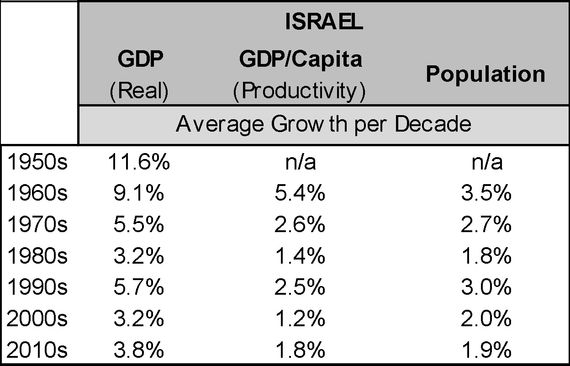
It was symbolic that Prime Minister Nikol Pashinyan’s August 2019 speech on his long term vision for Armenia took place in Stepanakert. The speech set ambitious targets to be achieved by 2050, including a population of 5 million, 1.5 million new jobs, eliminating poverty, and a GDP 15 times greater than today’s figures. Progress towards these goals would greatly impact Armenia’s economic prosperity and long-term sustainability.
This article will focus specifically on the GDP growth target of 1500 percent and examine the likelihood of hitting such a goal by 2050. The population target of 5,000,000 is also related and will thus be considered indirectly.
In order to study the matter at hand, this piece will use two approaches:
A historical analysis to find instances of other countries achieving such targets; A model of such a development scenario to determine what input parameters would be required to hit such goals. That is, which variables (ex. productivity, population growth) are most important to achieve the “2050-15xGDP” target.
Inflation-adjusted Numbers or Not? In local Currency Terms or Hard Currency?
The first order of business is to understand what is meant by 15x GDP growth. It is expected that most currencies will be worth less in 2050 than they are in 2019 due to inflation. It has also been the case that the currencies of developing countries like Armenia tend to register higher levels of inflation than developed economies, slipping in value over time when compared against the US dollar or the Euro. If the target is set in nominal (i.e. not inflation adjusted) AMD terms, reaching the “2050-15xGDP goal” is fully possible but the country would not actually be producing 15 times the value of today’s economic output. It would be more honest to consider the target in real ( inflation adjusted) US Dollars (or Euros), which makes it much more difficult to accomplish.
To compare the two ways of counting, over the 24 years between 1994 and 2018, Armenia’s GDPexpanded by 32 x in nominal AMD terms but only 4.1x in real USD terms.
Obviously, standards of living do not improve through higher inflation rates; similarly, Armenia’s foreign purchases of military equipment, as an example, are not paid in local currency but in US dollars. Real USD terms provide a more useful gauge of Armenia’s performance in relation to its peers and competitors.
The Real Numbers – Have we Seen Such Targets Hit Elsewhere?
For the purpose of a historical, cross-country analysis, real inflation-adjusted US Dollars have been used as a common denomination for all countries studied.
Armenia’s 2018 GDP of 13 billion USD was taken as a starting point, using 2010 constant/real US Dollars, as a base).
To account for both the Artsakh economy and a shadow economy that will begin to be accounted for in official numbers due to anti-corruption initiatives, this 13 billion USD figure is generously adjusted upwards by 25 percent. Fiscal revenues show that progress is already being made in this area so there is room for optimism. We assume that the shadow economy will be reduced from the currently-estimated 36 percent to approximately 15 percent of GDP.Under these assumptions, in order to reach the “2050-15xGDP” objective, the economy would need to grow by 8.1 percent per annum for the next 32 years.
The reader should note that this average number includes both economic booms and recessions, as well as any other domestically- or externally-originated economic headwind. Accordingly, 8.1 percent is quite an ambitious number. For perspective, current global growth runs at approximately 4 percent per annum.
Only five countries have achieved 15x GDP over a 30 year period in modern history:
-
Equatorial Guinea: 106xGDP, 1982-2012, due to oil/hydrocarbon discoveries;
-
Botswana: 26xGDP, 1961-1991, due to diamonds and nickel exports;
-
Oman: 24xGDP, 1965-1995, due to oil/hydrocarbon export reliance;
-
China: 19xGDP, 1981-2011, due to diversified economic restructuring;
-
South Korea: 16xGDP, 1962-1992, due to diversified economic restructuring.
Significant progress has also been made in other jurisdictions, but the examples above show how rare a 15x expansion is, especially when it is not dependent on mineral discoveries.
The post-1990s Regional Performance and the Case of the “Peer-five” and Israel
Context and wider economic trends do matter, whether it is the post-war reconstruction of the 1950s and 1960s, the inflationary 1970s and 1980s, the tech breakthroughs of the 1990s or the building and commodity booms of the 2000s.
For a more recent perspective on performance and the broader context Armenia has operated in, it makes sense to see how far regional peers have come since the fall of the Berlin Wall and the collapse of the Soviet Union, i.e. the last 30 years.
The first table lists the GDP performance of Eastern and Central European nations since 1990. It shows by how many times the respective economy has expanded since 1990 (again, in real USD terms). Poland’s GDP today is 2.79 times larger than it was in 1990. Similarly, Romania’s GDP today is 1.80 times larger. Consider that even joining the European Union did not bring these countries anywhere near 15x growth.
Economic expansions can be subdivided into a) productivity and b) labor-force/population increases. If one looks at the “Peer-five” nations of Lithuania, Israel, Estonia, Latvia and Poland, which can be interpreted as having the most heritage and cultural affinity to Armenia, then it is of interest to examine the degree to which demographics have aided these countries’ economic expansions.
The numbers are presented in the second table. Among the “Peer-five”, only Israel has seen meaningful population growth of 2.33% per annum between 1990 and 2018. This increase is due both to repatriation and higher birth rates. The attached chart shows net migration of the “Peer-five” countries as a percentage of their total population. It illustrates that Israel had quite large net migration inflows both at the origins of its statehood as well as after the fall of the USSR, when it experienced inflows of highly educated immigrants from the former Soviet republics (217,000 in 1990 alone).

Tables 1 and 2.

Examining the case of Israel in more detail and its early years in particular, one finds that its GDP by 1980 was 10x that of the nation’s GDP in 1950 (i.e. two years after its founding). That figure is quite impressive but still lower than the 15x target Pashinyan has set for Armenia. Also, one has to recognize that Armenia today is a far more mature economy than Israel was in the 1950s, when it was growing at double digit rates, especially with regard to credit saturation.

Modelling the 15x outcome – What is Required to Get There?
If historical precedents are limited, what prerequisites are needed for Armenia to achieve such an outcome? A proprietary, Armenia-specific model was used to consider such an outcome.
Obviously, as with any model, one can get any desired outcome by feeding it with numbers that have no realistic underpinnings. For the purpose of this article, the forward-looking assumptions have relied on numbers that were considered along the principle of “best possible outcome based on input-variables with historic precedents.”
The model relies on three basic inputs to reach the desired targets:
-
Materially boosted structural growth rates due to improved public management and transparency, higher levels of trust towards the government, political stability, reduced shadow economy, nepotism and graft, as well as a commitment to the adoption of advanced country best practices from faster technology adaptation to Sustainable Development Goals policies;
-
Significant reorientation of the labor force from agriculture employment towards high productivity IT and technology services;
-
Drastically improved demographics profile, with the population reaching 5 million by 2050.
In more practical terms, the necessary inputs in numerical terms as averages between 2019 and 2050 are:
-
Population growth: 1.6% (with peak at 3% in 2035)
-
Structural GDP Growth (Excl. IT & Tech Services): 4.25% (peak at 6.0% in 2024)
-
Structural GDP Growth (Incl. IT & Tech Services): 8.0% (peak at 11.3% in 2029)
-
Population in 2050: 5.01m
-
IT/TS as a share of GDP by 2050: 10.2% (from 4.5% in 2018)
-
Agriculture employment by 2050: 1.6% of population (from 11.3% in 2018)
All of these are very ambitious numbers for any economy and in any global economic context. One thing that might aid in achieving such an outcome is better healthcare, which would lead to people staying in the labor force longer.
Another potential boost would come from higher participation levels of women in the labor force. Equalized career opportunities and pay, as well as help with improved childcare infrastructure and incentive models, would lead to higher productivity outcomes both for women and for the Armenian economy overall. As an example, the current female labor force participation rate in Armenia is at 56 percent. In Sweden, it is 81 percent. In other words, there are plenty of plausible opportunities to catch-up, both on numbers as well as on the productivity side. Anecdotal evidence suggests that female participation in Armenian start-ups and in the tech sector is outstanding – even in international comparisons.
Conclusion
To summarize, the 2050-15xGDP goal is quite a stretch, on any level. Yet a government’s commitment to such ambitious targets does require it to pursue policies that aid and facilitate such an outcome, which is the important part.
The above modelled outcome relies upon three criteria: a) continued public governance reform and adaptation of best practices, b) a shift of the labor force to the IT and tech domain, and c) increased population growth and improved labor force utilization.
Encouragingly, that is exactly what we are seeing today – both as implicit government signaling on priorities and orientation as well as explicit policies such as tech educational initiatives, higher childcare benefits and many others. Whether this will be enough is unclear. There are also several others that could increase chances even further (e.g. higher savings rates).
With the accelerated pace and commitment that is being witnessed today, Armenia may achieve such targets after all! The results would be drastic indeed. As an example, the country’s GDP would move from being 33 percent of Lithuania’s, to three times its size by 2050 and from 5 percent of Israel’s GDP today to 26 percent in 2050. In relation to regional neighbors/adversaries, the outperformance would be even starker.
--------------------
* World Bank Databank, World Development Indicators
** IMF Working Paper (2018, WP/18/17): “Shadow Economies Around the World: What Did We Learn Over the Last 20 Years?”
*** Boston Consulting Group research as presented in the Financial Times, Sep 24, 2019: “Developing economies can become engines of innovation”
by the same author
Has Armenia’s Growth Outlook Improved?
By Samson Avetian
Samson Avetian looks at a number of variables that can impact Armenia’s economic growth outlook and writes that despite the challenges, the Velvet Revolution has catalyzed and facilitated meaningful improvement and thus raised longer run GDP growth projections.
Taxes, Governance and the New Armenia
By Samson Avetian
There has been much discussion about the new tax reform being proposed by Armenia’s new government. Samson Avetian teases out some of the key issues of the reform.
Armenia’s Investment Potential is Substantial, But Internal Discourse Needs to Be Carefully Managed
By Samson Avetian
There is potential for an increase in investment activity in Armenia. Expectations of entrepreneurs need to be carefully managed in order to see this acceleration happen already as early as 2019, writes Samson Avetian.
Comments
Grigor (Gregory) Areshian
11/4/2019, 9:45:26 PMWell-written and useful article that provides a lot of food for thought. Unfortunately the existing serious risks are not brought up.
Yevgenya Paturyan
11/4/2019, 7:36:51 AMA very informative, well-structured, well-argumented article that helps lift the lever of public debate.







EVN Report welcomes comments that contribute to a healthy discussion and spur an informed debate. All comments will be moderated, thereby any post that includes hate speech, profanity or personal attacks will not be published, including abusive, threatening, racist, sexist, offensive, misleading or libelous language. Comments deemed to be spam or solely promotional in nature will not be published. Including a link to relevant content is permitted, but comments should be relevant to the post topic.